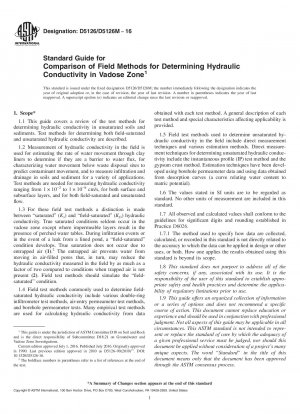ASTM D5126/D5126M-16
Standard Guide for Comparison of Field Methods for Determining Hydraulic Conductivity in Vadose Zone
- Standard No.
- ASTM D5126/D5126M-16
- Release Date
- 2016
- Published By
- American Society for Testing and Materials (ASTM)
- Status
- Replace By
- ASTM D5126-16e1
- Latest
- ASTM D5126-16e1
- Scope
5.1 Saturated hydraulic conductivity measurements are made for a variety of purposes varying from design of landfills and construction of clay liners to assessment of irrigation systems. Infiltrometers are commonly used where infiltration or percolation rates through a surface or subsurface layer are desired. Evaluation of the rate of water movement through a pond liner is one example of this kind of measurement. Penetration of the liner by a borehole would invalidate the measurement of liner permeability. It has been noted that small-ring infiltrometers are subject to error due to lateral divergence of flow. Therefore, techniques using very large (1 to 2-m diameter) infiltration basins have been recommended for measuring the very slow percolation rates typically needed for clay liners. The air-entry permeameter can be used instead of infiltrometer tests to avoid lateral divergence of flow. However, because a cylinder must be driven into the media tested, the actual soil column tested may be disrupted by introduction of the cylinder, especially in structured soils.
5.2 Borehole tests for determining saturated hydraulic conductivity are applicable for evaluating the rate of water movement through subsurface layers. For slowly permeable layers, an accurate method of measuring the rate of water movement into the borehole will need to be developed. Use of a flexible bag as a reservoir that can be periodically weighed is advisable for these conditions. A number of mathematical solutions for borehole outflow data are available (Stephens et al. (17), Reynolds et al. (18), and Philip (19)).
5.3 Information on unsaturated flow rates is needed to design hazardous waste landfills and impoundments where prevention of flow of contaminants into groundwater is needed. Of the test methods available, the primary differences are cost and resultant bias and precision. The instantaneous profile test method appears to provide very reliable data because it uses a large volume of soil (several cubic metres) and is performed on undisturbed soils in the field. However, a single test can cost several thousand dollars. The gypsum crust test method, although more rapid than the instantaneous profile test method, sacrifices precision of results due to the smaller spatial extent of the tested area. Methods for estimating unsaturated hydraulic conductivity from fundamental soil hydraulic functions like the desorption curves may deviate from true values by an order of magnitude, but may be of use where relative differences in permeability between materials or across water content ranges is of interest.
Note 1: The quality of the result produced by this standard is dependent on the competence of the personnel performing it, and the suitability of the equipment and facilities used. Agencies that meet the criteria of Practice D3740 are generally considered capable of competent and objective testing/sampling/inspection/etc. Users of this standard are cautioned in that compliance with Practice D3740 does not in itself assure reliable results. Reliable results depends on many factors; Practice D3740
ASTM D5126/D5126M-16 Referenced Document
- ASTM D2434 Standard Test Method for Permeability of Granular Soils (Constant Head)
- ASTM D3385 Standard Test Method for Infiltration Rate of Soils in Field Using Double-Ring Infiltrometer
- ASTM D3740 Standard Practice for Minimum Requirements for Agencies Engaged in the Testing and/or Inspection of Soil and Rock as Used in Engineering Design and Construction
- ASTM D4643 Standard Test Method for Determination of Water Content of Soil and Rock by Microwave Oven Heating
- ASTM D6026 Standard Practice for Using Significant Digits in Geotechnical Data
- ASTM D653 Standard Terminology Relating to Soil, Rock, and Contained Fluids
ASTM D5126/D5126M-16 history
- 2016 ASTM D5126-16e1 Standard Guide for Comparison of Field Methods for Determining Hydraulic Conductivity in Vadose Zone
- 2016 ASTM D5126/D5126M-16 Standard Guide for Comparison of Field Methods for Determining Hydraulic Conductivity in Vadose Zone
- 1990 ASTM D5126/D5126M-90(2010)e1 Standard Guide for Comparison of Field Methods for Determining Hydraulic Conductivity in Vadose Zone
- 1990 ASTM D5126-90(2004) Standard Guide for Comparison of Field Methods for Determining Hydraulic Conductivity in the Vadose Zone
- 1990 ASTM D5126-90(1998)e1 Standard Guide for Comparison of Field Methods for Determining Hydraulic Conductivity in the Vadose Zone

Copyright ©2024 All Rights Reserved